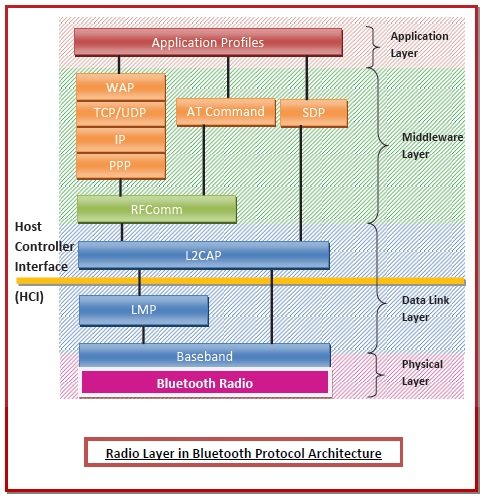
 Data Structure
Data Structure Networking
Networking RDBMS
RDBMS Operating System
Operating System Java
Java MS Excel
MS Excel iOS
iOS HTML
HTML CSS
CSS Android
Android Python
Python C Programming
C Programming C++
C++ C#
C# MongoDB
MongoDB MySQL
MySQL Javascript
Javascript PHP
PHP
- Selected Reading
- UPSC IAS Exams Notes
- Developer's Best Practices
- Questions and Answers
- Effective Resume Writing
- HR Interview Questions
- Computer Glossary
- Who is Who
The Bluetooth Radio Layer
The Bluetooth radio layer is the lowest layer of Bluetooth architecture that corresponds to the physical layer of the OSI model. It lays down the physical structure and specifications for the transmission of radio waves.
The position of the radio layer depicted in the following diagram −

Characteristic Features of Bluetooth Radio Layer
The Bluetooth radio layer lays down the requirements of the Bluetooth transceiver device that communicates using Bluetooth technology.
It defines air interface, frequency bands, frequency hopping specifications, and modulation techniques.
This layer is responsible for moving data bits from the master device to the slave device, and vice versa.
It is a low-power system working within a range of 10 meters.
It operates in the unlicensed 2.4 GHz ISM (Industrial, Scientific, and Medical) radio band as does IEEE 802.11 networks or WiFi.
The band is separated into 79 channels each of 1 MHz.
In order to avoid interference from other networks operating in the ISM band, it uses Frequency Hopping Spread Spectrum (FHSS).
Each device changes its modulation frequency 1600 times per second, i.e. there are 1600 hops/sec. The dwell time is 625 μsec.
It uses adaptive frequency hopping for adjusting its hop sequence to exclude channels where there are other radio-frequency signals (RF signals).

